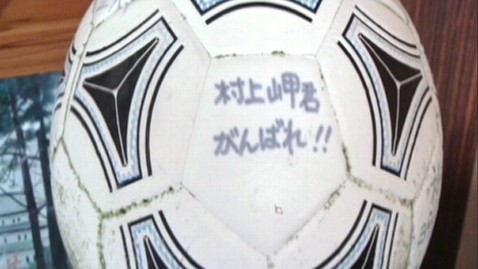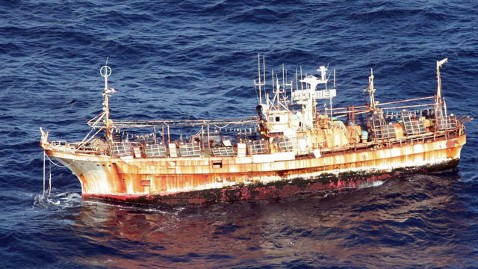Reuters
By Rie Ishiguro | MANILA (Reuters) - Japan could face "the day of reckoning" sooner than expected if the government fails to raise the sales tax and investors demand higher returns on government bonds, Moody's Investors Service said on Wednesday, ...
the day of reckoning 悪事の清算日; 最後の審判の日.
May 1, 2012 4:05pm
Japan Tsunami Debris: Canadian Museum Launches Recovery Project
Pieces of debris from last year’s Japanese tsunami, carried by
the currents, have begun to show up on the West Coast of the United
States and Canada, including most recently, a Harley Davidson
motorcycle.
The Maritime Museum of British Columbia has just launched what it calls the “Tsunami Debris Project”, which aims to collect photos of the flotsam that washes ashore and potentially reunite lost items with their owners.
“The idea is to not only document, but to showcase them in an exhibit type of way, and to tell the social and human side of the story with the idea that there might be a few items that come over that have some personal or sentimental value for these people that have lost everything,” project coordinator Linda Funk told ABCNews.com. “And it would be the right thing to do to link some of these belongings to their owners.”
The museum says it hopes the website will be a central place for flotsam finders to post photos of the items and for people in Japan to look for their valued belongings.
Three items that have so far washed up and made news are a soccer ball, a wrecked ship and a motorcycle.
 In April, the soccer ball
washed up on the shore of a remote island in Alaska, making it one of
the first pieces of debris to reach the U.S. The radar technician who
found the ball with Japanese writing on it was able to track down the
elementary school it came from and, eventually, its owner, a 16-year-old
who had lost his home in the tsunami.
In April, the soccer ball
washed up on the shore of a remote island in Alaska, making it one of
the first pieces of debris to reach the U.S. The radar technician who
found the ball with Japanese writing on it was able to track down the
elementary school it came from and, eventually, its owner, a 16-year-old
who had lost his home in the tsunami.
The Japanese “ghost ship,” the Ryou-Un Maru, floated across the Pacific Ocean after it was ripped from its moorings by the tsunami last March. It was floating roughly 195 miles south of Sitka in the Gulf of Alaska before the U.S. Coast Guard shot at it and sank it on April 5 after it was decided that it was not worth salvaging.
 And just a few weeks ago, a man from Masset, Canada was riding his
ATV on a remote beach on the island of Haida Gwaii when he came across a
large, white container that looked like the back of a truck on the
beach, according to the CBC.
And just a few weeks ago, a man from Masset, Canada was riding his
ATV on a remote beach on the island of Haida Gwaii when he came across a
large, white container that looked like the back of a truck on the
beach, according to the CBC.
Inside was a Harley Davidson motorcycle with Japanese license plates. The container also had camping equipment, golf clubs and tools in it, the CBC reported.
These are just the first of what experts predict will be massive amounts of debris set to reach the North American coast in 2013.
“Most of the things will be fishing floats or pieces of lumber, non-interesting debris, but there’s bound to be a couple of items that are like the soccer ball,” Funk said. “It’s a bit like a treasure hunt. You never know what you’re going to find.”
The Maritime Museum of British Columbia has just launched what it calls the “Tsunami Debris Project”, which aims to collect photos of the flotsam that washes ashore and potentially reunite lost items with their owners.
“The idea is to not only document, but to showcase them in an exhibit type of way, and to tell the social and human side of the story with the idea that there might be a few items that come over that have some personal or sentimental value for these people that have lost everything,” project coordinator Linda Funk told ABCNews.com. “And it would be the right thing to do to link some of these belongings to their owners.”
The museum says it hopes the website will be a central place for flotsam finders to post photos of the items and for people in Japan to look for their valued belongings.
Three items that have so far washed up and made news are a soccer ball, a wrecked ship and a motorcycle.

(Image credit: ABC News)
The Japanese “ghost ship,” the Ryou-Un Maru, floated across the Pacific Ocean after it was ripped from its moorings by the tsunami last March. It was floating roughly 195 miles south of Sitka in the Gulf of Alaska before the U.S. Coast Guard shot at it and sank it on April 5 after it was decided that it was not worth salvaging.

(Image credit: U.S. Coast Guard/AP Photo)
Inside was a Harley Davidson motorcycle with Japanese license plates. The container also had camping equipment, golf clubs and tools in it, the CBC reported.
These are just the first of what experts predict will be massive amounts of debris set to reach the North American coast in 2013.
“Most of the things will be fishing floats or pieces of lumber, non-interesting debris, but there’s bound to be a couple of items that are like the soccer ball,” Funk said. “It’s a bit like a treasure hunt. You never know what you’re going to find.”
 Email
Email
沒有留言:
張貼留言